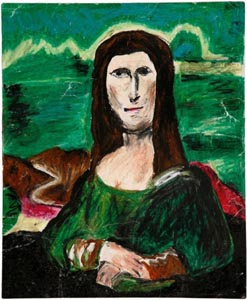The idea of high art and low art is instinctively known to most of us with even the most rudimentary art education. High art is the serious stuff, low art is made for the masses.
You can spot the difference in where it lives, high art resides in museums, galleries, and Sotherby auctions while low art is sold at poster shops and displayed on college door room walls.
Van Gogh, Picasso, Rembrandt vs. Richie Rich comics, Disney World t-shirts, and stolen stop signs.
But high art and low art lines become blurred with the pop art movement of the 60s and 70s when suddenly artists dove into low culture imagery to use in their paintings.

Instead of finding inspiration in the classics – Greek Myths, historic battles, and Bible stories, the Pop artists turned to the themes of everyday life such as superheroes, canned soup, celebrities, and news events.
Previously high art dealt with the exploration of what is a painting – can it be paint dripped on a canvas or giant floating squares of color or even just blocks of solid color stacked on top of each other — this new version of high art turned a mirror on modern society, took imagery from the every day and turned it back upon its audience.

One way of looking at the concept of High vs. Low art comes from the familiar saying “art for art’s sake” – that is art created to serve no other purpose than to be art. Art for display. Art for decoration. In contrast, low art forms is art created for a different purpose from illustrations in a children’s book to art used on the cover of a novel or in advertising.
The artwork on a pinball machine would be considered low art. Soda advertisements are low art. Times Square is full of low art.
The concept of high and low can be traced back to 18th-century ideas about fine art and craft. Writers in the 1700s drew a line between work that is contemplated purely for aesthetics (fine art) and work that has some sort of utility or function (craft). The fine art grouping of painting, sculpture, music, architecture and poetry was established at this time. The familiar phrase “art for art’s sake” comes out of this view, and is so culturally pervasive that many people accept it as the “correct” way to classify art.
Matt Plescher
In terms of value high and low art are treated much differently. You might see a friend with a collection of Disney artwork all over their house. This type of art has value to collectors of the genre but not much beyond value to the collector base, whereas high art has value within the art market. Collector market vs. art market.

Typically low art is mass-produced. Take the “Big Eyes” paintings of Keane. Just about everyone had a print of these paintings back in the 1970s because they were sold in places like Sears. Vintage prints of these famous paintings don’t fetch much these days as they were made and sold by the thousands. Even an original Big Eye painting doesn’t sell for all that much.
An iconic “Big Eyes” painting by Margaret D. H. Keane offered at Worth Auctions on November 27, 2016 fetched over $12,500—the artist’s second-highest price on record.
http://www.worthauctions.com/index.php/margaret-keane-big-eyes-painting/
Similarly, the artwork on a vintage pinball machine doesn’t fetch that much money for the actual artwork. Pinball collectors are mainly concerned about many factors of a pinball machine that supersede collecting them for the value of the art. For example, game-play is higher on the list of factors that determine the overall value. Newer machines from the 1970s often fetch higher prices than older, rarer machines with better artwork from the 40s, 50s and 60s – due to the playability of the newer machines.
The artwork on these machines is simply part of the overall package unlike high art where the artwork is the total package.

